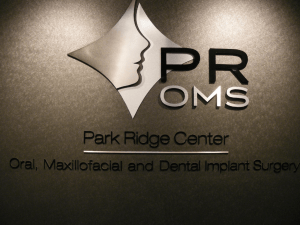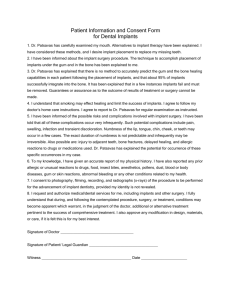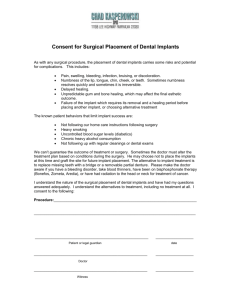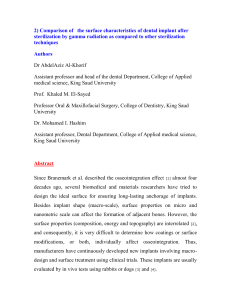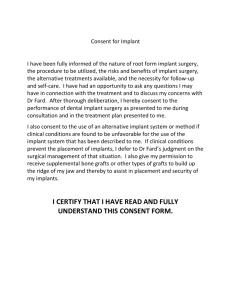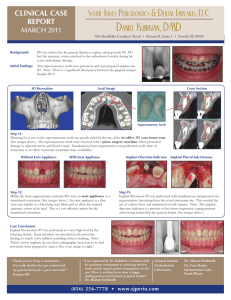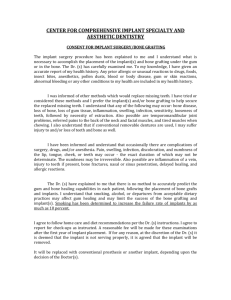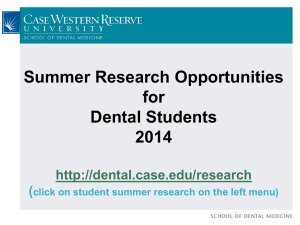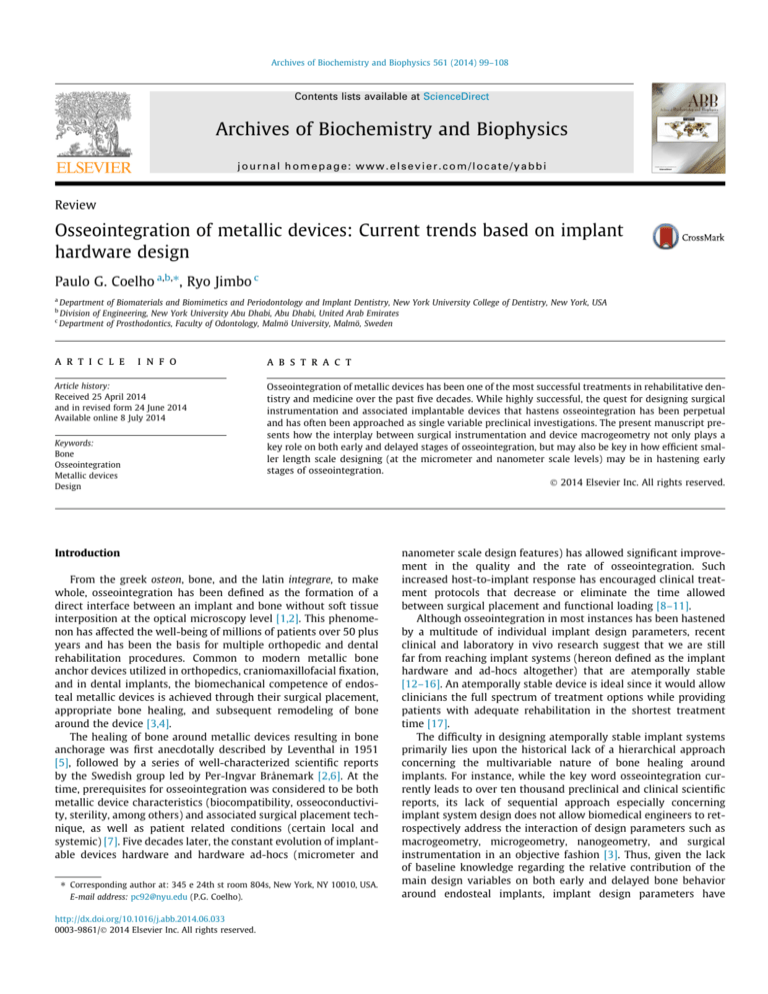
Archives of Biochemistry and Biophysics 561 (2014) 99–108
Contents lists available at ScienceDirect
Archives of Biochemistry and Biophysics
journal homepage: www.elsevier.com/locate/yabbi
Review
Osseointegration of metallic devices: Current trends based on implant
hardware design
Paulo G. Coelho a,b,⇑, Ryo Jimbo c
a
Department of Biomaterials and Biomimetics and Periodontology and Implant Dentistry, New York University College of Dentistry, New York, USA
Division of Engineering, New York University Abu Dhabi, Abu Dhabi, United Arab Emirates
c
Department of Prosthodontics, Faculty of Odontology, Malmö University, Malmö, Sweden
b
a r t i c l e
i n f o
Article history:
Received 25 April 2014
and in revised form 24 June 2014
Available online 8 July 2014
Keywords:
Bone
Osseointegration
Metallic devices
Design
a b s t r a c t
Osseointegration of metallic devices has been one of the most successful treatments in rehabilitative dentistry and medicine over the past five decades. While highly successful, the quest for designing surgical
instrumentation and associated implantable devices that hastens osseointegration has been perpetual
and has often been approached as single variable preclinical investigations. The present manuscript presents how the interplay between surgical instrumentation and device macrogeometry not only plays a
key role on both early and delayed stages of osseointegration, but may also be key in how efficient smaller length scale designing (at the micrometer and nanometer scale levels) may be in hastening early
stages of osseointegration.
Ó 2014 Elsevier Inc. All rights reserved.
Introduction
From the greek osteon, bone, and the latin integrare, to make
whole, osseointegration has been defined as the formation of a
direct interface between an implant and bone without soft tissue
interposition at the optical microscopy level [1,2]. This phenomenon has affected the well-being of millions of patients over 50 plus
years and has been the basis for multiple orthopedic and dental
rehabilitation procedures. Common to modern metallic bone
anchor devices utilized in orthopedics, craniomaxillofacial fixation,
and in dental implants, the biomechanical competence of endosteal metallic devices is achieved through their surgical placement,
appropriate bone healing, and subsequent remodeling of bone
around the device [3,4].
The healing of bone around metallic devices resulting in bone
anchorage was first anecdotally described by Leventhal in 1951
[5], followed by a series of well-characterized scientific reports
by the Swedish group led by Per-Ingvar Brånemark [2,6]. At the
time, prerequisites for osseointegration was considered to be both
metallic device characteristics (biocompatibility, osseoconductivity, sterility, among others) and associated surgical placement technique, as well as patient related conditions (certain local and
systemic) [7]. Five decades later, the constant evolution of implantable devices hardware and hardware ad-hocs (micrometer and
⇑ Corresponding author at: 345 e 24th st room 804s, New York, NY 10010, USA.
E-mail address: pc92@nyu.edu (P.G. Coelho).
http://dx.doi.org/10.1016/j.abb.2014.06.033
0003-9861/Ó 2014 Elsevier Inc. All rights reserved.
nanometer scale design features) has allowed significant improvement in the quality and the rate of osseointegration. Such
increased host-to-implant response has encouraged clinical treatment protocols that decrease or eliminate the time allowed
between surgical placement and functional loading [8–11].
Although osseointegration in most instances has been hastened
by a multitude of individual implant design parameters, recent
clinical and laboratory in vivo research suggest that we are still
far from reaching implant systems (hereon defined as the implant
hardware and ad-hocs altogether) that are atemporally stable
[12–16]. An atemporally stable device is ideal since it would allow
clinicians the full spectrum of treatment options while providing
patients with adequate rehabilitation in the shortest treatment
time [17].
The difficulty in designing atemporally stable implant systems
primarily lies upon the historical lack of a hierarchical approach
concerning the multivariable nature of bone healing around
implants. For instance, while the key word osseointegration currently leads to over ten thousand preclinical and clinical scientific
reports, its lack of sequential approach especially concerning
implant system design does not allow biomedical engineers to retrospectively address the interaction of design parameters such as
macrogeometry, microgeometry, nanogeometry, and surgical
instrumentation in an objective fashion [3]. Thus, given the lack
of baseline knowledge regarding the relative contribution of the
main design variables on both early and delayed bone behavior
around endosteal implants, implant design parameters have
100
P.G. Coelho, R. Jimbo / Archives of Biochemistry and Biophysics 561 (2014) 99–108
primarily been researched in a single variable fashion. Such
approach, although economically viable and straightforward, may
not necessarily capture the true efficiency of such variable in
osseointegration since other design parameters are not evaluated
in a systematic approach.
For instance, a MEDLINE literature search demonstrated that
implant surface design investigations outnumbered all the other
implant design parameter investigations by two orders of magnitude. While it is definitely desirable to design improved surfaces
that will hasten osseointegration, its relative contribution when
other parameters change (for instance, two different implant systems presenting distinct macrogeometry and surgical instrumentation and the same surface treatment) is seldom reported in the
literature [18] and does not contribute in a step wise fashion to
the development of an informed design platform for the improvement of implant systems.
It is unquestionable that osseointegration is determined by
numerous factors such as surgical drilling protocols, drilling speed,
implant macrogeometry, implant micrometer and nanometer scale
engineering, and status of the host bone quality [7,19,20].
Discretely, some of the parameters have been investigated in
numerous animal studies [21,22,15,23–25] and combined effects
of different design parameters intentionally considered in multifactorial study designs [18] have not been extensively investigated.
It is of great importance to assemble the available scientific evidence in an attempt to identify the role of each parameter that
affects osseointegration. Thus, the objective of this manuscript
was to provide in a structured manner a first step towards how
implant design features potentially influence osseointegration.
We have based the starting point of this critical review in how
implant hardware (bulk device design and related surgical
instrumentation dimensions) influences short- and long-term
ossoeintegration. Then, the effect of the here defined implant hardware ad-hocs (micrometer and nanometer design alterations) is
discussed in light of how these features can more efficiently be
incorporated in implant systems’ design as a function of initial
implant hardware design.
The effect of implant hardware in bone healing pathway and
long-term osseointegration
It is a general consensus that properly cleaned and sterilized
biocompatible titanium-based alloys (primarily comprised by
commercially pure Ti and Ti-6Al-4V) devices will be incorporated
within the bone tissue after installation [3]. The scientific literature
has extensively described that after some time following implantation, an intimate contact between bone and endosteal device will
biomechanically stabilize these bone anchors that are utilized for
multiple purposes [26–29]. Far less explored in the literature is
how osseointegration temporally occurs around endosteal
implants substantially vary as a function of two major key implant
design parameters: implant macrogeometry and its associated surgical instrumentation dimensions [4,30]. While it is obvious that
two different design parameters are under consideration, their
contribution to healing cannot be considered separately, rationalizing the term implant hardware, a factor which is the primary driver of how osseointegration is established around endosteal
devices [4,30].
Interfacial remodeling healing pathway
Arguably, one of the most important aspects with regards to
achieving osseointegration clinically is implant initial stability.
Initial or primary stability, also known as mechanical stability, is
the sole mechanical interlocking between the bone and the
implant where there exists no biologic interplay [22,31]. It must
be emphasized here again that the initial stability cannot be
regarded as osseointegration since osseointegration is the result
of the osteoconduction of the implant system. The mechanical
interlocking is influenced by the implant geometry and topography
at different levels, as well as the implant osteotomy protocols,
which all regulate the strain applied to the hard tissue in proximity
of the implant [29,32,33]. Strain is directly related to bone-implant
interfacial stress and frictional force, which is expressed clinically
as insertion torque [22,28,34].
In general, higher insertion torque of the implant is endemically
perceived as higher primary stability, which has been clinically
regarded as an indication for procedures such as immediate loading [35]. The theoretical background to this concept is that the
bone is assumed to be an elastic material and that strain and
implant stability will have a linear relationship [22]. However, in
reality, the stability of the implant would decrease beyond the
yield strain of the bone due to excessive microcrack formation
and compression necrosis; both phenomena trigger bone remodeling [22,36,37]. Although microcrack formation is regarded as an
important phenomenon for the intracortical remodeling [38],
excessive microcrack formation however has the risk of generating
a macrocrack (fracture) through interconnection of unrepaired
individual microcracks [39,40]. Compression necrosis occur when
the hard tissue around the implant is faced with excessive strain,
where the circulation in the capillaries are severely damaged
[41]. The ischemic status of the bone is generated by compression
of the bone, which subsequently results in the necrosis and resorption of the bone [42]. Both microcracking and compression necrosis are observed to different degrees when a mismatch between
implant thread outer diameter and surgical instrumentation inner
diameter occurs. Thus, depending on the thread design and its
related surgical instrumentation dimension, different degrees of
friction and interlock between implant and bone will be generated
leading to higher or lower degrees of insertion torque, a clinically
measurable parameter that is often perceived, despite experimental evidence proving otherwise [17,43], proportional to implant
primary stability (resistance to micromotion under loading).
High degrees of insertion torque must be questioned since
excessive strain not only leads to the decrease of biomechanical
stability, but also provokes negative biologic responses depending
on the implant thread design that influence bone compression levels [17]. Such cell mediated bone resorption and subsequent bone
apposition from the pristine bone wall towards the implant surface
is responsible for what has under theoretical [44] and experimental [45] basis been coined as implant stability dip, where high
degrees of initial stability (primary stability) obtained through
the mismatch between implant macrogeometry and surgical
instrumentation dimension is lost due to the cell-mediated interfacial remodeling; to be subsequently regained through bone apposition [44,46].
This healing mode scenario is presented in Fig. 1. It is imperative to note at this stage that canine bone healing takes place substantially faster (controversy exists in the literature regarding to its
magnitude, beyond the scope of this manuscript) than humans and
the phenomena described throughout the course of this manuscript should be temporally spaced out when translated to
humans. Fig. 1 depicts V-shaped threaded implants that were
placed in sites that were surgically instrumented to dimensions
matching the inner diameter of the implant threads (Fig. 1) [47].
The optical micrographs presented in Fig. 1 were obtained from
implants that remained in vivo for 2 and 4 weeks in a canine laboratory model. At 2 weeks in vivo (Fig. 1a), the almost continuous
bone-implant interface revealed mechanical interlocking between
components, responsible for the implant primary stability. At
2 weeks, microcracks at regions where the yield strength of bone
P.G. Coelho, R. Jimbo / Archives of Biochemistry and Biophysics 561 (2014) 99–108
101
Fig. 1. Optical micrographs of V-threaded implants placed in sites surgically instrumented to the inner diameter of the implant thread at (a) 2 weeks and (b) 4 weeks in vivo
in a beagle dog model. (a) At 2 weeks in vivo, the almost continuous bone-implant interface reveals mechanical interlocking between components, responsible to the implant
primary stability. The red arrows depict micro cracks at regions where the yield strength of bone has been exceeded due to high stress concentration; the blue arrow depicts
initial remodeling taking place between the implant threads due to compression necrosis. (b) At 4 weeks, substantial remodeling has occurred at the interface where cell
mediated processes resorbed the region encompassed between the dashed line and the implant. A remodeling site occurring at the extension of a microcrack is depicted by a
green arrow.
has been exceeded due to high stress concentration are easily
depicted along with initial remodeling taking place between the
implant threads due to compression necrosis. At 4 weeks
(Fig. 1b), a substantial remodeling region forms due to the coalescence of bone remodeling sites due to compression necrosis and/or
micrcracking. Remodeling sites occurring in the proximity of
microcracks can also be observed along with void spaces partially
filled by newly formed bone that occurred between 2 and 4 weeks
in vivo following the cell mediated remodeling [47].
The scenario depicted in Fig. 1 histologically confirms the theoretical and experimental basis [44,45] for the initial stability rendered by mechanical interlocking between implant and bone that
at some point in time between 2 and 4 weeks decreased due to
extensive resorption. Subsequently, the resorbed volume will be
filled by newly formed woven bone1, which eventually reestablishes
the contact to the implant interface (secondary stability), and as per a
plethora of implant retrieval studies has shown, bone in proximity to
the implant has remodeled multiple times to a lamellar configuration
that will support the metallic device throughout its lifetime [48–53].
Following this osseointegration pathway, it is a general consensus that further bone remodeling occurs under functional loading
resulting in higher degrees of bone organization [54]. Morphologically, however, bone surrounding these implants has been often
described as compact mature lamellar bone with few and small
marrow spaces [55,48] (Fig. 2). To date, no human retrieval study
concerning implants that primarily heal through this pathway at
dense bone regions has presented sufficiently large sample size
to determine their time course alteration in histomorphometric
and mechanical properties of osseointegration.
Intramembranous-like healing pathway (healing chamber
osseointegration)
The second osseointegration pathway concerns the opposite
scenario of implants tightly fit in bone, where void spaces between
the implant bulk and the surgically instrumented drilled site walls
are formed [56]. These void spaces left between bone and implant
bulk, often referred as healing chambers, will be filled with blood
clot immediately after placement and will not contribute to primary stability. These however, have been regarded as a key contributor to secondary stability [30,57].
The early healing biology and kinetics of bone formation in
healing chambers has been discussed in detail by Berglundh
1
Abbreviations used: BOM, bone organic matrix; OB, osteoblasts; MBF, mineralizing
bone front; WB, woven bone; CB, cortical bone plate; LB, lamellar bone.
Fig. 2. A human retrieved sample at approximately 8 years of functional loading
showing direct agreement with other reports for screw type implants placed in
undersized drilled sites. The bone surrounding these implants present a compact
mature lamellar bone with few and small marrow spaces.
et al. [56] while the effect of healing chamber size and shape on
bone formation has been explored by Marin et al. [58]. Such healing chambers, upon implant placement, are immediately filled
with the blood clot that will evolve towards osteogenic tissue that
subsequently ossifies through an intramembranous-like pathway
[56]. Thus, it can be said that the chamber type of implants may
be beneficial since the blood in contact to the implant will promote
direct new bone formation and skip the biologic clean up process
of the necrotic bone by multinucleated cells [18,56].
This osseointegration pathway has been temporally characterized in multiple preclinical studies, where independent of species
(including humans), bone formation through the intramembranous-like pathway leads to rapid healing chamber filling with
woven bone (Fig. 3a) [58,56,59,60]. The woven bone is subsequently replaced by lamellar bone surrounding multiple primary
osteonic structures throughout the healing chamber volume
(Fig. 3b) [30]. Moreover, bone filling occurs from all surfaces
bounding the healing chambers (surgically instrumented bone wall
and implant surface) through contact osteogenesis, as well bone
nucleation occurs throughout the chamber volume [30,57,58,61].
Several reports have demonstrated osteocyte lacunae in close
proximity with the implant surface without hard or soft interposing tissue at the optical microscopy level demonstrating that bone
forming cells can easily navigate through the osteogenic tissue that
102
P.G. Coelho, R. Jimbo / Archives of Biochemistry and Biophysics 561 (2014) 99–108
Fig. 3. Optical micrographs of healing chamber implants that remained (a) 3 weeks and (b) 5 weeks in vivo in a beagle dog model. (a) At 3 weeks in vivo, woven bone (WB)
lining the surgically instrumented cortical bone plate (CB) and throughout the volume of the healing chamber region. (b) At 5 weeks, replacement of woven bone (WB) by
lamellar bone (LB) throughout the healing chamber is depicted along with primary osteonic structures (O) were reveal that onset of woven bone remodeling towards lamellar
configuration surrounding blood vessels. (c) Since immediately after placement the void region rendered due to the implant macro geometry and surgical instrumentation
outer dimension is readily filled with a blood clot and healing takes place in an intramembranous-like pathway where cells readily migrate throughout the fibrin network,
osteoblasts are able to directly populate the implant surface prior to matrix deposition, resulting in lacunae (L) directly in contact and in close proximity with the implant
surface. Lines of cube shaped cells (osteoblasts, OB) depositing bone organic matrix (BOM) directly over the mineralizing bone front (MBF) are readily observed.
originates from the blot clot towards the implant surface at early
times after implant placement (Fig. 3c) and promote contact osteogenesis [57,58]. Human retrieval studies concerning the temporal
morphology of implants that primarily heal through healing chambers have shown that the primary osteonic structure achieved over
the first six months to a year after placement (Fig. 4a) remodels
over time under functional loading evolving towards a haversianlike structure regardless of location in the maxilla or mandible
[51,62]. While a haversian-like morphology is achieved after one
year after placement (Fig. 4b–c), nanomechanical evaluation of
these human retrieved implants have shown that it is not until
after approximately 5 years under functional loading that the
haversian-like configuration significantly increase in mechanical
property (both hardness and elastic modulus) [63]. Thus, while
low levels of primary stability is achieved when pure healing
chamber implants are tapped into surgically instrumented sites
drilled to the dimension of the implant outer diameter, the resulting healing mode presents substantial deviation from the classic
interfacial remodeling healing pathway. Although the initial stability may not be as high as the interfacial remodeling implants, it is
known that the chamber implants possess sufficient level of primary stability (low micromotion) obtained with the tip of the
implant threads or plateaus, stable enough for the blood clot
trapped within chambers to enable the development of a highly
osteogenic stroma through which osteogenic cells migrate resulting in osseointegration [30,57,58,61].
Fig. 4. Optical micrographs representative of (a) implants that were loaded up to 1 year in vivo that presented a mixed bone morphology with regions of woven (w) and
lamellar bone surrounding primary osteonic structures (O). Implants that remained loaded for longer periods of time such as in (b) 5 years and (c) 18 years primarily
presented a haversian-like lamellar structure.
P.G. Coelho, R. Jimbo / Archives of Biochemistry and Biophysics 561 (2014) 99–108
Temporal comparison between interfacial remodeling and
intramembranous-like healing pathways
As confirmed by several preclinical studies [4,64–66] and more
specific by a comparative study by Leonard et al. [30] comparing
experimental groups presenting the two macrogeometry/surgical
instrumentation parameters above described, high mechanical
interlocking is immediately achieved when an implant system is
placed under conditions that will lead to the interfacial remodeling
healing pathway (Fig. 1a), whereas low mechanical interlocking is
achieved immediately after placement of an implant system that
will lead to the healing chamber intramembranous-like healing
pathway. Shortly after, while the primary stability is substantially
decreasing due to extensive cell-mediated interfacial remodeling
(Fig. 1b), rapid woven bone filling is taking place within the healing
chambers initiating osseointegration (Fig. 3a). Thereafter, at the
time which secondary stability is achieved around the osseointegrating implant that presented the interfacial remodeling healing
pathway, replacement of woven bone by lamellar bone leading to
primary osteonic structures are observed throughout the volume
of the healing chambers (Fig. 3b). At longer healing times, both
osseointegrated implants will present bone morphologic evolution
towards more organized structures (Figs. 2 and 4). As per previous
long-term human retrieval studies [51,62], the main difference in
bone evolution over time between healing pathways is that the
primary osteonic structures present within healing chambers, possibly due to the higher cellular and vascular content, will evolve
towards a haversian-like structure (Fig. 4) whereas a compact
mature lamellar bone with few and small marrow spaces will be
observed around implants which osseointegrated through interfacial remodeling (Fig. 2) [55,48]. While the long-term mechanical
properties of bone formed through the intramembranous-like
healing pathways has been determined [63], a consistent data set
has not yet been generated for implants that osseointegrated
through the interfacial remodeling healing pathway.
Integrating interfacial remodeling and intramembranous-like bone
healing modes through implant hardware design: the hybrid healing
pathway
The compilation of investigations thus far presented on how the
dimensional interplay between implant macrogeometry and surgical instrumentation affects the bone healing pathway has provided
new insight regarding how implant systems can be further modified to provide scenarios where implant stability can be immediately achieved and may be temporally maximized [4,18,58,64].
Recent investigations have employed either experimental implant
designs with an outer thread design that provided stability while
the inner thread and osteotomy dimensions allowed healing chambers [56,67,68] or alterations in osteotomy dimensions in large
thread pitch implant designs [4,64,65]. The rationale for these
alterations lie upon the fact that thread designing may allow for
both high degrees of primary stability along with a surgical instrumentation outer diameter that is closer to the outer diameter of
the implant allowing healing chamber formation. Since no bone
resorption occurs in healing chambers and rapid intramembranous-like rapid woven bone formation occurs [69], such rapid bone
growth may compensate for the implant stability loss due to compression regions where implant contacts bone for primary
stability.
For instance, previous work has demonstrated a healing mode
shift by incrementally increasing the final surgical instrumentation
dimension from drilling to a dimension lower than the inner
implant thread, to the dimension of the implant inner thread diameter, and to the implant outer thread diameter (Fig. 5) [17,64,65].
When the surgical instrumentation dimension was below the size
103
of the implant inner thread, substantial interfacial remodeling
occurred over time (Fig. 5a, b, e and f). When surgical instrumentation was closer to the implant outer thread dimensions, healing
chambers formed and bone healed through the intramembranous-like pathway (Fig. 5c and f). These investigations highlighted
that while all implants presented adequate primary stability (note
that the study was conducted in beagle dogs; higher bone mechanical properties than humans) the higher torque values obtained
during placement of the two smaller surgical instrumentation
dimensions did not necessarily result in temporal healing scenarios
that would maximize the implant-in-bone biomechanical competence [64,65].
Different than altering surgical drilling dimension to obtain
hybrid healing, implants presenting power thread designs to
assure primary stability have been deliberately designed for placement into surgically instrumented sites with dimensions larger
than the inner thread aspect of the implant (Fig. 6) [17,66]. Relative
to the micrographs presented in Fig. 1, a lower extension of bone
resorption (interfacial remodeling) takes place at regions where
the implant threads engage bone for primary stability between 2
and 4 weeks [66,70]. In tandem with this interfacial remodeling
that decrease implant primary stability levels achieved by partial
engagement of the implant power threads and bone, woven bone
formation occurred within the healing chamber region potentially
compensating for the stability loss (Fig. 6) [66,70]. Fig. 7 illustrates
a time point where implant hardware allowed for healing chamber
filling (secondary stability well underway) in tandem with bone
resorption at the regions that provided primary stability.
Since the concept of hybrid healing provides an alternative
route for implant hardware designing that may possibly render
atemporally stable devices, current work on the field is incipient
and further characterization of such healing as a function of macrogeometry design and associated surgical instrumentation is warranted to maximize both primary and secondary stability. Since
very few and recently made commercially available systems present this hardware configuration, the long-term effect of hybrid
healing on osseointegration is years form being evaluated. Nonetheless, it is somewhat expected that a combination of a compact
lamellar and haversian-like structures will result due to the presence of bone interfacial remodeling and intramembranous-like
components during early healing.
Surgical drilling technique and its effect on the different bone healing
pathways
It is general consensus that the goal of the surgical procedure is to
obtain adequate implant hardware fit and that surgical instrumentation dimension and its relationship to implant macrogeometry
may substantially alter the course of osseointegration. However, it
is surprising how surgical instrumentation investigations are by
far the least numerous in the osseointegration literature. Drilling
technique can influence the osteotomy accuracy, a feature that is
of extreme importance if one is attempting to modulate implant
hardware influence in healing mode and the degree of primary
and secondary stability achieved over time [15,23,24,71].
Unlike for the case which implant hardware results in interfacial remodeling healing mode, where bone damage due to surgical
instrumentation is likely to be overcome by the bone damage due
to compression osteonecrosis and microcracking, implant hardware leading to intramembranous-like and hybrid healing may
have their biomechanical competence over time set back due to
surgical instrumentation damage.
In the case of healing chambers (intramembranous-like healing), where little primary stability is achieved and biomechanical
competence is achieved through chamber filling with bone, it is
obvious that the lower the damage to the drilled wall, less
104
P.G. Coelho, R. Jimbo / Archives of Biochemistry and Biophysics 561 (2014) 99–108
Fig. 5. 1 Week in vivo optical micrographs of the implant-bone interface showing that implants placed into (a) 3.2 mm and (b) 3.5 mm drilling sites presented necrotic bone
areas in the region between the first three implant threads (white arrows). Implants placed into (c) 3.8 mm drilling sites presented a chamber (depicted by red arrows) filled
with osteogenic tissue between the implant inner diameter and the drilled wall. Initial osteoid nucleation was observed in minor amounts within the healing chamber (blue
arrow). 3 Weeks in vivo optical micrographs of the implant-bone interface showing that implants placed into (d) 3.2 mm and (e) 3.5 mm drilling sites presented extensive
remodeling along with newly formed bone. At 3 weeks, implants placed into (f) 3.8 mm drilling sites presented extensive woven bone formation at the drilled bone walls,
implant surface, and within the healing chamber volume.
resorption of such wall will occur and lesser the volume to be filled
through the intramembranous healing pathway [71]. A more complex scenario arises in the case of implant hardware that relies on
hybrid healing, since a temporal balance between healing modes is
required for an atemporally stable implant system design. For this
hardware design, surgical drilling technique must be carefully
accounted since osteotomy line dieback (presented in Fig. 7) will
invariably occur, potentially altering balance of the in tandem
P.G. Coelho, R. Jimbo / Archives of Biochemistry and Biophysics 561 (2014) 99–108
105
Fig. 6. Optical micrographs at (a) 2 weeks in vivo and (b) 4 weeks in vivo in a beagle model. The red arrows depict newly formed bone at the healing chambers regions; yellow
arrows depict bone remodeling regions.
Fig. 7. Implant in bone presenting hybrid healing at the time when the regions that engaged bone due to a mismatch between implant thread outer diameter and surgical
instrumentation outer diameter (blue line) present extensive remodeling (red arrows). Note the partial presence of bone replacing the void spaces from remodeling dark
stained bone in proximity with the void spaces denoted by the red arrows). In tandem, bone growth at the healing chambers took place from all available surfaces
(instrumented surface after its dieback due to surgical instrumentation – green line).
relationship of primary and secondary stability. For instance,
excessive drilled wall retraction due to dieback will not only
decrease primary stability due to lesser engagement between
implant thread and pristine bone but also increase the healing
chamber component responsible for assuring implant stability
when interfacial remodeling occurs at the regions that assured primary stability during placement. Thus, understanding how drilling
parameters affect drilled bone dieback is key for fine-tuning
implant hardware temporal stability.
Drilling speed has a direct influence on heat generation to the
surrounding bone [72]. It has been suggested that low drilling in
general increases the wobbling and results in the over preparation
of the osteotomy site [73]. Other studies suggest that lower drilling
speed generate more heat than procedures with high drilling
speeds [74–76]. The effect of overheat during drilling has been suggested to impair bone formation around the implant due to the
thermal osteonecrosis [77]. Reports indicate that an overheat in
the bone exceeding 47 °C for one minute would provoke an irreversible biologic response, which would cause thermal injury to
the bone [78]. While it is a fact that necrotic bone contributes to
the stability of the implant at the moment the implant is installed
[79], it has been experimentally determined that osteoclasts will
be activated due to the local surgical instrumentation damage
and/or osteocyte death [80–82]. On the contrary, Yeniol et al. have
demonstrated higher degrees of osseointegration for implants
placed in sites prepared under low speed drilling [15]. Accordingly,
Giro et al. [71] reported lower bone dieback degree when low
speed drilling was used for osteotomy relative to high speed drilling [71]. Thus, while studies suggest that slower speeds may result
in site overdrilling due to wobbling and higher temperatures that
may damage the bone [15,72–74,83], a recent experimental study
has shown higher degrees of osseointegration and lower degrees of
bone dieback occurring when slow speed drilling (<400 rpm) is
employed, warranting further investigations concerning bone
damage mechanism determination [15]. Unlike anecdotally
employed over several decades, a series of recent studies have
demonstrated that the number of drills sequentially employed to
achieve the final osteotomy dimension has no effect on osseointegration rates [23,24]. Unfortunately, the body of literature concerning surgical instrumentation is sparse and contradictory, and even
though a higher number of investigations concerning its effect on
bone healing around implants have been conducted over the past
106
P.G. Coelho, R. Jimbo / Archives of Biochemistry and Biophysics 561 (2014) 99–108
three years, it is imperative that more investigations are carried
out if implant hardware design is to be improved.
While promising developments have been made over the last 5
decades regarding implant hardware designing and how it does
dictate bone healing and long-term bone morphology around endosteal implants, it is widely recognized that other design features
do hasten osseointegration and can further increase the performance of implant hardware [3]. Implant hardware design ad-hocs,
comprising micrometer and nanometer length scale designing
(usually explored as surface topography designing), are widely
known for their influence in the initial stages of osseointegration.
It must be however stressed that the microtopography on the
implant surface indeed has an effect on the primary stability of
implants since these have the ability to increase friction between
implant and bone during placement [84]. However, the fact that
such increase in primary stability occurs at the expense of the surface integrity at regions where cell-mediated interfacial remodeling will occur prior to osseointegration (where osteoclastogenesis
will be activated in order to clean the necrotic bone tissue and
bone remains), it is intuitive that healing chamber regions are
more prone to enable hastened biological effects of micrometer
and the nanometer length scale designing.
Implant hardware ad-hocs – engineering at the micrometer and
nanometer length scale levels
Multiple implant design ad-hocs have been extensively investigated when one considers micrometer and nanometer length scale
modifications [3]. Surface chemistry and biologic modifications are
known to hasten early osseointegration. Since this review primarily concerns metallic implant design effects on osseointegration,
detailed description of this ad-hoc design parameters are beyond
the scope of this manuscript.
Both experimental and clinical evidence with regards to
implant surface micro-topography and their biologic responses
has shown to present significant benefits in terms of osseointegration [85,86]. Biomechanically, the expanded surface area of the
moderately rough implant surface, which is in contact with the
surrounding bone tissue, increases the friction coefficient during
implant insertion. Along with implant macro-geometry, the
increased friction naturally provides higher implant primary stability [87]. The high primary stability of the implant provides a stable host bed, and only after this, the biological effect of the surface
micrometer and nanometer scale structures exert their osteogenic
effects. The high primary stability and the osteoconductive surface
in contact to blood clots within the chamber allows growth factors
and cells to successfully adhere to the implant surface [88].
One important issue is the common misconception with regards
to the effect of nanotopography on early osseointegration. It must
be clearly stated that nanotopography has no correlation on the
primary stability and is only effective in achieving secondary (biologic) stability. It has been proven that nanotopography, if strategically applied, presents enhanced osteoconductivity [89]. It has
been demonstrated that the application of nanotopography not
only enhances osseointegration, but also improves the nanomechanical properties of the surrounding bone [20]. As stated, this
early effect of the nanotopography is effective where the implant
has adequate stability in the bone, allowing the same to be faced
with enough osteogenic cells to interact with the surface. Such
interaction between ostegenic tissue and surface nanotopography
has been the subject of cell culture [90–94], preclinical animal
models [95], and human retrieval studies [96] that unequivocally
show gene expression alteration due to the presence of nanometer
scale features on the implant surface. While most investigators
suggest that such gene expression alteration is likely due to the
direct interaction between cells and surfaces, other studies involv-
ing early interaction between the surface and biofluids clearly indicate that protein adsorption/desorption kinetics is drastically
affected by nanometer scale designing [97–100]. Thus, systematic
research targeting design structure and surface proteome at early
implantation times are highly desirable to further understanding
the effect of nanometer scale features in the early host-to-implant
interaction.
Other considerations and final remarks
Bone quality of the implantation site is another important
aspect that needs to be considered since the bone density, blood
supply and cellular content vary depending on the type of the bone
[101]. This is an important future consideration since it is quite
obvious that the implant hardware configuration should be altered
based on the quality of the bone and for the time present, the hardware interplay to maximize implant stability over time in different
bone types is not well understood. It may be speculated that the
lower the bone density, the higher the mixed amount of interfacial
remodeling and intramembranous-like bone healing modes will be
present. However, this must be determined in future studies
through multifactorial study designs, where hardware is first
adjusted as a function of bone density for primary stability maximization, and adequate hardware ad-hoc if then adapted to the
hardware to maximize secondary stability achievement.
Understanding the interplay between the metallic implant
hardware and the living body has not been extensively considered
in a non-systematic fashion. It is an alarming fact that there exist
several implant configurations and surgical instrumentation that
have been commercially introduced without proper consideration.
While bone is the factor that without doubt supports the basis for a
long-term functional and esthetic reconstruction, osseointegration
must be revisited and recognized as a complex multivariable process. There is an endemic misconception that the implant should
present high insertion torque upon surgery, and the surface should
be moderately rough at the micrometer level with nanostructures
present. This is off course in part a proven fact especially when
variables are individually considered, but their individual contribution to initial and long-term osseointegration is yet to be determined through extensive experimentation. Thus, even though the
science supporting osseointegration has come a long way to enable
an initial assessment of how discrete design features affect bone
surrounding implants, considerable work lies ahead of biomedical
engineers if a true multifactorial design optimization is to be adequately performed.
Acknowledgments
Both authors (PC and RJ) equally contributed to the content of
this manuscript. Both authors would like to express their immense
gratitude to all collaborators and students involved in all research
projects leading to this compilation.
References
[1] T. Albrektsson, C. Johansson, Eur. Spine J. 10 (Suppl. 2) (2001) S96–S101.
[2] P.I. Branemark, B.O. Hansson, R. Adell, U. Breine, J. Lindstrom, O. Hallen, A.
Ohman, Supplementum 16 (1977) 1–132.
[3] P.G. Coelho, J.M. Granjeiro, G.E. Romanos, M. Suzuki, N.R. Silva, G. Cardaropoli,
V.P. Thompson, J.E. Lemons, Appl. Biomater. 88 (2009) 579–596.
[4] P.G. Coelho, M. Suzuki, M.V. Guimaraes, C. Marin, R. Granato, J.N. Gil, R.J.
Miller, Clin. Implant Dent. Relat. Res. 12 (2010) 202–208.
[5] G.S. Leventhal, J. Bone Joint Surg. Am. 33-A (1951) 473–474.
[6] R. Adell, U. Lekholm, B. Rockler, P.I. Branemark, Int. J. Oral Surg. 10 (1981)
387–416.
[7] T. Albrektsson, P.I. Branemark, H.A. Hansson, J. Lindstrom, Acta Orthop. Scand.
52 (1981) 155–170.
[8] H. De Bruyn, T. Van de Velde, B. Collaert, Clin. Oral Implants Res. 19 (2008)
717–723.
P.G. Coelho, R. Jimbo / Archives of Biochemistry and Biophysics 561 (2014) 99–108
[9] S. Shigehara, S. Ohba, K. Nakashima, Y. Takanashi, I. Asahina, J. Oral Implantol.
(2014) [Epub ahead of print].
[10] S. Vervaeke, B. Collaert, H. De Bruyn, Int. J. Oral Maxillofac. Implants 28 (2013)
1352–1357.
[11] S. Vandeweghe, C. Nicolopoulos, E. Thevissen, R. Jimbo, A. Wennerberg, H. De
Bruyn, Int. J. Prosthod. 26 (2013) 458–464.
[12] H. Browaeys, M. Dierens, C. Ruyffelaert, C. Matthijs, H. De Bruyn, S.
Vandeweghe, Clin. Implant Dent. Relat. Res. (2014), http://dx.doi.org/
10.1111/cid.12197 [Epub ahead of print].
[13] D.A. Deporter, J. Kermalli, R. Todescan, E. Atenafu, Int. J. Period. Restor. Dent.
32 (2012) 563–570.
[14] R. Jimbo, R. Anchieta, M. Baldassarri, R. Granato, C. Marin, H.S. Teixeira, N.
Tovar, S. Vandeweghe, M.N. Janal, P.G. Coelho, Implant Dent. 22 (2013) 596–
603.
[15] S. Yeniyol, R. Jimbo, C. Marin, N. Tovar, M.N. Janal, P.G. Coelho, Oral Surg. Oral
Med. Oral Pathol. Oral Radiol. 116 (2013) 550–555.
[16] R. Jimbo, N. Tovar, D.Y. Yoo, M.N. Janal, R.B. Anchieta, P.G. Coelho, Clin. Oral
Implants Res. (2013), http://dx.doi.org/10.1111/clr.12216 [Epub ahead of
print].
[17] R. Jimbo, N. Tovar, C. Marin, H.S. Teixeira, R.B. Anchieta, L.M. Silveira, M.N.
Janal, J.A. Shibli, P.G. Coelho, Int. J. Oral Maxillofac. Surg. (2014), http://
dx.doi.org/10.1016/j.ijom.2014.03.017 [Epub ahead of print].
[18] P.G. Coelho, R. Granato, C. Marin, H.S. Teixeira, M. Suzuki, G.B. Valverde, M.N.
Janal, T. Lilin, E.A. Bonfante, J. Mech. Behav. Biomed. Mater. 4 (2011) 1974–
1981.
[19] T.J. Oh, J. Yoon, C.E. Misch, H.L. Wang, J. Periodontol. 73 (2002) 322–333.
[20] R. Jimbo, P.G. Coelho, M. Bryington, M. Baldassarri, N. Tovar, F. Currie, M.
Hayashi, M.N. Janal, M. Andersson, D. Ono, S. Vandeweghe, A. Wennerberg, J.
Dent. Res. 91 (2012) 1172–1177.
[21] R. Chowdhary, A. Halldin, R. Jimbo, A. Wennerberg, Implant Dent. 22 (2013)
91–96.
[22] A. Halldin, R. Jimbo, C.B. Johansson, A. Wennerberg, M. Jacobsson, T.
Albrektsson, S. Hansson, Bone 49 (2011) 783–789.
[23] G. Giro, N. Tovar, C. Marin, E.A. Bonfante, R. Jimbo, M. Suzuki, M.N. Janal, P.G.
Coelho, Int. J. Biomater. 2013 (2013) 230310.
[24] R. Jimbo, G. Giro, C. Marin, R. Granato, M. Suzuki, N. Tovar, T. Lilin, M. Janal,
P.G. Coelho, J. Periodontol. 84 (2013) 1599–1605.
[25] C.M. Aegerter, L. Shi, L. Shi, L. Wang, Y. Duan, W. Lei, Z. Wang, J. Li, X. Fan, X. Li,
S. Li, Z. Guo, PLoS ONE 8 (2013) e55015.
[26] J.E. Ellingsen, C.B. Johansson, A. Wennerberg, A. Holmen, Int. J. Oral
Maxillofac. Implants 19 (2004) 659–666.
[27] P.G. Coelho, H.S. Teixeira, C. Marin, L. Witek, N. Tovar, M.N. Janal, R. Jimbo,
Appl. Biomater. 102 (2014) 430–440.
[28] R. Chowdhary, A. Halldin, R. Jimbo, A. Wennerberg, Clin. Implant Dent.
Relat. Res. (2013), http://dx.doi.org/10.1111/cid.12143 [Epub ahead of
print].
[29] J. Gottlow, S. Barkarmo, L. Sennerby, Clin. Implant Dent. Relat. Res. 14 (2012)
e204–e212.
[30] G. Leonard, P. Coelho, I. Polyzois, L. Stassen, N. Claffey, Clin. Oral Implants Res.
20 (2009) 232–239.
[31] M. Norton, Int. J. Oral Maxillofac. Implants 28 (2013) 19–21.
[32] F. Isidor, Clin. Oral Implants Res. 17 (2006) 8–18.
[33] C.S. Petrie, J.L. Williams, Clin. Oral Implants Res. 16 (2005) 486–494.
[34] H.-L. Huang, Y.-Y. Chang, D.-J. Lin, Y.-F. Li, K.-T. Chen, J.-T. Hsu, Clin. Oral
Implants Res. 22 (2011) 691–698.
[35] F. Javed, G.E. Romanos, J. Dent. 38 (2010) 612–620.
[36] O. Verborgt, G.J. Gibson, M.B. Schaffler, J. Bone Miner. Res. 15 (2000) 60–67.
[37] A. Chamay, P. Tschantz, J. Biomech. 5 (1972) 173–180.
[38] V. Bentolila, T.M. Boyce, D.P. Fyhrie, R. Drumb, T.M. Skerry, M.B. Schaffler,
Bone 23 (1998) 275–281.
[39] D.B. Burr, M.R. Forwood, D.P. Fyhrie, R.B. Martin, M.B. Schaffler, C.H. Turner, J.
Bone Miner. Res. 12 (1997) 6–15.
[40] D.B. Burr, C.H. Turner, P. Naick, M.R. Forwood, W. Ambrosius, M. Sayeed
Hasan, R. Pidaparti, J. Biomech. 31 (1998) 337–345.
[41] T.M. Zizic, C. Marcoux, D.S. Hungerford, J.V. Dansereau, M.B. Stevens, Am. J.
Med. 79 (1985) 596–604.
[42] J.D. Bashutski, N.J. D’Silva, H.-L. Wang, J. Periodontol. 80 (2009) 700–704.
[43] A.C. Freitas Jr., E.A. Bonfante, G. Giro, M.N. Janal, P.G. Coelho, Clin. Oral
Implants Res. 23 (2012) 113–118.
[44] S. Raghavendra, M.C. Wood, T.D. Taylor, Int. J. Oral Maxillofac. Implants 20
(2005) 425–431.
[45] J.B. Gomes, F.E. Campos, C. Marin, H.S. Teixeira, E.A. Bonfante, M. Suzuki, L.
Witek, D. Zanetta-Barbosa, P.G. Coelho, Int. J. Oral Maxillofac. Implants 28
(2013) e128–e134.
[46] R. Jimbo, T. Sawase, Y. Shibata, K. Hirata, Y. Hishikawa, Y. Tanaka, K. Bessho, T.
Ikeda, M. Atsuta, Biomaterials 28 (2007) 3469–3477.
[47] E.A. Bonfante, R. Granato, C. Marin, R. Jimbo, G. Giro, M. Suzuki, P.G. Coelho,
Int. J. Oral Maxillofac. Implants 28 (2013) 136–142.
[48] C. Mangano, V. Perrotti, M. Raspanti, F. Mangano, G. Luongo, A. Piattelli, G.
Iezzi, Int. J. Oral Maxillofac. Implants 28 (2013) 917–920.
[49] G. Iezzi, A. Piattelli, C. Mangano, J.A. Shibli, G. Vantaggiato, M. Frosecchi, C.
Chiara, V. Perrotti, Odontology 102 (2012) 116–121.
[50] G. Iezzi, G. Vantaggiato, J.A. Shibli, E. Fiera, A. Falco, A. Piattelli, V. Perrotti,
Quintessence Int. 43 (2012) 287–292.
[51] P.G. Coelho, E.A. Bonfante, C. Marin, R. Granato, G. Giro, M. Suzuki, J. Long
Term Eff. Med. Implants 20 (2010) 335–342.
107
[52] P.G. Coelho, C. Marin, R. Granato, M. Suzuki, Appl. Biomater. 91B (2009) 975–
979.
[53] A. Piattelli, L. Artese, E. Penitente, F. Iaculli, M. Degidi, C. Mangano, J.A. Shibli,
P.G. Coelho, V. Perrotti, G. Iezzi, Appl. Biomater. 102 (2014) 239–243.
[54] J.E. Davies, J. Dent. Educ. 67 (2003) 932–949.
[55] G. Iezzi, A. Piattelli, C. Mangano, J.A. Shibli, G. Vantaggiato, M. Frosecchi, C. Di
Chiara, V. Perrotti, Odontology 102 (2014) 116–121.
[56] T. Berglundh, I. Abrahamsson, N.P. Lang, J. Lindhe, Clin. Oral Implants Res. 14
(2003) 251–262.
[57] P.G. Coelho, R. Granato, C. Marin, E.A. Bonfante, M.N. Janal, M. Suzuki, Oral
Surg. Oral Med. Oral Pathol. Oral Radiol. Endod. 109 (2010) e39–e45.
[58] C. Marin, R. Granato, M. Suzuki, J.N. Gil, M.N. Janal, P.G. Coelho, Clin. Oral
Implants Res. 21 (2010) 577–583.
[59] D. Buser, N. Broggini, M. Wieland, R.K. Schenk, A.J. Denzer, D.L. Cochran, B.
Hoffmann, A. Lussi, S.G. Steinemann, J. Dent. Res. 83 (2004) 529–533.
[60] D.D. Bosshardt, G.E. Salvi, G. Huynh-Ba, S. Ivanovski, N. Donos, N.P. Lang, Clin.
Oral Implants Res. 22 (2011) 357–364.
[61] M. Suzuki, M.D. Calasans-Maia, C. Marin, R. Granato, J.N. Gil, J.M. Granjeiro,
P.G. Coelho, J. Oral Maxillofac. Surg. 68 (2010) 1631–1638.
[62] P.G. Coelho, C. Marin, R. Granato, M. Suzuki, Appl. Biomater. 91 (2009) 975–
979.
[63] M. Baldassarri, E. Bonfante, M. Suzuki, C. Marin, R. Granato, N. Tovar, P.G.
Coelho, Appl. Biomater. 100 (2012) 2015–2021.
[64] F.E. Campos, J.B. Gomes, C. Marin, H.S. Teixeira, M. Suzuki, L. Witek, D.
Zanetta-Barbosa, P.G. Coelho, J. Oral Maxillofac. Surg. 70 (2012) e43–e50.
[65] P.G. Coelho, C. Marin, H.S. Teixeira, F.E. Campos, J.B. Gomes, F. Guastaldi, R.B.
Anchieta, L. Silveira, E.A. Bonfante, J. Oral Maxillofac. Surg. 71 (2013) e69–
e75.
[66] E.A. Bonfante, R. Granato, C. Marin, M. Suzuki, S.R. Oliveira, G. Giro, P.G.
Coelho, Int. J. Oral Maxillofac. Implants 26 (2011) 75–82.
[67] I. Abrahamsson, T. Berglundh, E. Linder, N.P. Lang, J. Lindhe, Clin. Oral
Implants Res. 15 (2004) 381–392.
[68] I. Abrahamsson, E. Linder, N.P. Lang, Clin. Oral Implants Res. 20 (2009) 313–
318.
[69] L. Witek, C. Marin, R. Granato, E.A. Bonfante, F.E. Campos, J.B. Gomes, M.
Suzuki, P.G. Coelho, Int. J. Oral Maxillofac. Implants 28 (2013) 694–700.
[70] E.A. Bonfante, M.N. Janal, R. Granato, C. Marin, M. Suzuki, N. Tovar, P.G.
Coelho, Clin. Oral Implants Res. 24 (2013) 1375–1380.
[71] G. Giro, C. Marin, R. Granato, E.A. Bonfante, M. Suzuki, M.N. Janal, P.G. Coelho,
J. Oral Maxillofac. Surg. 69 (2011) 2158–2163.
[72] S. Iyer, C. Weiss, A. Mehta, Int. J. Prosthod. 10 (1997) 411–414.
[73] J. Lindstrom, P.I. Branemark, T. Albrektsson, Scand. J. Plast. Reconstr. Surg. 15
(1981) 29–38.
[74] M. Sharawy, C.E. Misch, N. Weller, S. Tehemar, J. Oral Maxillofac. Surg. 60
(2002) 1160–1169.
[75] M.B. Abouzgia, J.M. Symington, Int. J. Oral. Maxillofac. Surg. 25 (1996) 394–
399.
[76] G. Augustin, S. Davila, K. Mihoci, T. Udiljak, D.S. Vedrina, A. Antabak, Arch.
Orthop. Trauma Surg. 128 (2008) 71–77.
[77] R.A. Eriksson, T. Albrektsson, B. Magnusson, Scand. J. Plast. Reconstr. Surg. 18
(1984) 261–268.
[78] A. Eriksson, T. Albrektsson, B. Grane, D. McQueen, Int. J. Oral Surg. 11 (1982)
115–121.
[79] B. McKibbin, J. Bone Joint Surg. Br. 60-B (1978) 150–162.
[80] D.B. Burr, C. Milgrom, D. Fyhrie, M. Forwood, M. Nyska, A. Finestone, S.
Hoshaw, E. Saiag, A. Simkin, Bone 18 (1996) 405–410.
[81] A.L. Bronckers, W. Goei, G. Luo, G. Karsenty, R.N. D’Souza, D.M. Lyaruu, E.H.
Burger, J. Bone Miner. Res. 11 (1996) 1281–1291.
[82] J. Klein-Nulend, R.G. Bacabac, M.G. Mullender, Pathol. Biol. 53 (2005) 576–
580.
[83] S. Iyer, C. Weiss, A. Mehta, Int. J. Prosthod. 10 (1997) 536–540.
[84] C.N. Elias, F.A. Rocha, A.L. Nascimento, P.G. Coelho, J. Mech. Behav. Biomed.
Mater. 16 (2012) 169–180.
[85] T. Albrektsson, A. Wennerberg, Int. J. Prosthod. 17 (2004) 544–564.
[86] A. Tabassum, G.J. Meijer, J.G.C. Wolke, J.A. Jansen, Clin. Oral Implants Res. 21
(2010) 213–220.
[87] M.V. dos Santos, C.N. Elias, J.H. Cavalcanti Lima, Clin. Implant Dent. Relat. Res.
13 (2011) 215–223.
[88] S. Lossdorfer, Z. Schwartz, L. Wang, C.H. Lohmann, J.D. Turner, M. Wieland,
D.L. Cochran, B.D. Boyan, J. Biomed. Mater. Res. A 70 (2004) 361–369.
[89] R. Jimbo, M. Andersson, S. Vandeweghe, Int. J. Dent. 2014 (2014) 314819.
[90] V. Bucci-Sabattini, C. Cassinelli, P.G. Coelho, A. Minnici, A. Trani, D.M. Dohan
Ehrenfest, Oral Surg. Oral Med. Oral Pathol. Oral Radiol. Endod. 109 (2010)
217–224.
[91] R. Liu, T. Lei, V. Dusevich, X. Yao, Y. Liu, M.P. Walker, Y. Wang, L. Ye, J.
Prosthod. 22 (2013) 641–651.
[92] C. Masaki, G.B. Schneider, R. Zaharias, D. Seabold, C. Stanford, Clin. Oral
Implants Res. 16 (2005) 650–656.
[93] M. Monjo, C. Petzold, J.M. Ramis, S.P. Lyngstadaas, J.E. Ellingsen, Int. J.
Biomater. 2012 (2012) 181024.
[94] S. Valencia, C. Gretzer, L.F. Cooper, Int. J. Oral Maxillofac. Implants 24 (2009)
38–46.
[95] P.G. Coelho, T. Takayama, D. Yoo, R. Jimbo, S. Karunagaran, N. Tovar, M.N.
Janal, S. Yamano, Bone 65C (2014) 25–32.
[96] G.N. Thalji, S. Nares, L.F. Cooper, Clin. Oral Implants Res. (2013), http://
dx.doi.org/10.1111/clr.12266 [Epub ahead of print].
108
P.G. Coelho, R. Jimbo / Archives of Biochemistry and Biophysics 561 (2014) 99–108
[97] D.W. Hamilton, D.M. Brunette, Biomaterials 28 (2007) 1806–1819.
[98] L. Leclercq, E. Modena, M. Vert, J. Biomater. Sci. Polym. Ed. 24 (2013) 1499–
1518.
[99] D. Yang, X. Lu, Y. Hong, T. Xi, D. Zhang, Biomaterials 34 (2013)
5747–5758.
[100] W.F. Zambuzzi, P.G. Coelho, G.G. Alves, J.M. Granjeiro, Biotechnol. Bioeng. 108
(2011) 1246–1250.
[101] J.A. Shibli, S. Grassi, A. Piattelli, G.E. Pecora, D.S. Ferrari, T. Onuma, S. d’Avila,
P.G. Coelho, R. Barros, G. Iezzi, Clin. Implant Dent. Relat. Res. 12 (2010) 281–
288.

